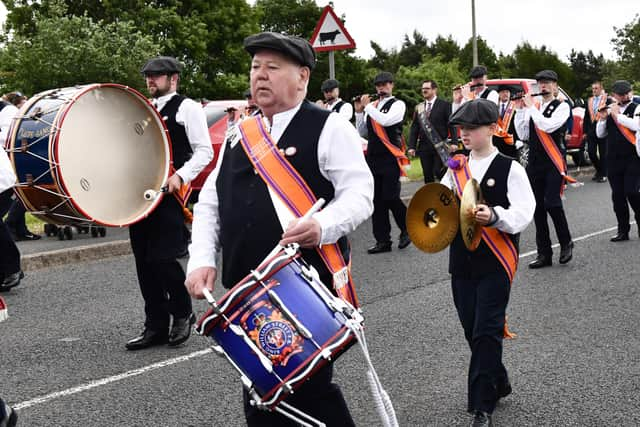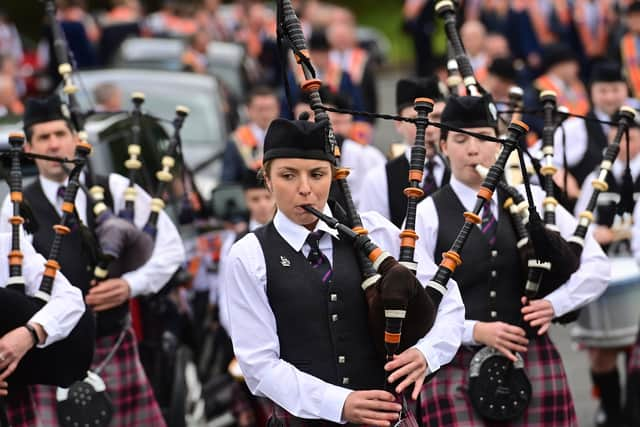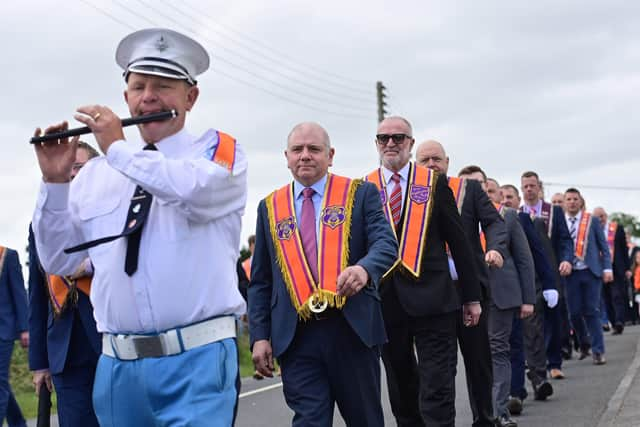Altnaveigh Massacre centenary: IRA ‘ethnic cleansing’ of six Protestants in their homes still ‘an open wound’ 100 years on, says cleric
and live on Freeview channel 276
The small Protestant community came under attack by an IRA gang at their rural homes, located a mile from Newry and five miles from the Irish border on the main Belfast-Dublin Road on 17 June, 1922. The attack was led by Frank Aiken who fled to the Irish Republic and later became its minister of external affairs.
Those murdered were Thomas Crozier, 61, and his wife Eliza, 56, John Heslip, 51, and his son Robert, 19, James Lockhart, 25, and Joseph Gray, aged 19.
Advertisement
Hide AdAdvertisement
Hide AdEvery year since the massacre, relatives and Orangemen from lodges in Newry and Bessbrook districts have gathered at Altnaveigh Orange hall for a memorial service. Today up to 300 Orangemen paraded to the Orange Hall to mark the centenary accompanied by Orange Order Grand Secretary Rev Mervyn Gibson and Harold Henning, Deputy Grand Master.


A sermon was given by retired non-subscribing Presbyterian Minister Rev Norman Hutton.
“This is very much still an open wound in the community,” he told the News Letter.
He said that no statement was ever issued to try and justify the attack and that nobody was ever charged. Eye witnesses reported that neighbours known to the victims took part in the attacks.
Advertisement
Hide AdAdvertisement
Hide Ad“Rumours were later spread that those killed were members of the security forces but this was definitely not true,” he said.


Last year also commemorated death of local man Draper C Holmes who was murdered by the IRA while working on the railway line, he said.
“The families targeted were very small scale Protestant farmers, cultivating just a few acres,” he said.
“It was an early stage of ethnic cleansing. Basically they were attacked because of one thing - because they were Protestants. All four families attacked were Presbyterian”
Advertisement
Hide AdAdvertisement
Hide AdThe minister at the time of Downshire Road Presbyterian Church, Phineas McKee was horrified at the attack on four members of his congregation.


“There were some locals who probably guided them into these small farms and then they made their escape over the nearby border.”
He said survivors of the atrocities recounted how the victims knew the first names of their killers.
“They evidently had local connections.”
He affirmed that the IRA used the long standing tactic of murdering the father and eldest son who was due to inherit the farm in order to “ethnically cleanse” the rest of the family from the area.
Advertisement
Hide AdAdvertisement
Hide Ad“That is very much what happened,” he said. “This was repeated in areas like Fermanagh and the rest of south Armagh.”
The same tactic was used repeatedly by the IRA in decades since 1922 along the border, he said.
“None of the people murdered at Altnaveigh were in the security forces. There were other similar murders happening at the time along the border.
“The brutality was terrible. In The Crozier house the father got up to see who was at the time and they burst in and shot him. His wife Elizabth came running out and shouted “Mick, Mick” to one of the gunmen
Advertisement
Hide AdAdvertisement
Hide Adindicating that she knew him and she was shot dead too. She evidently knew who it was.”
But one of those murdered showed true Christian spirit before dying, he said.
“Young Joseph Gray was in the general hospital being treated for four terrible gunshot wounds when somebody said ‘this was terrible’.
“And he replied: “I forgive them and I hope that God will forgive them too’. It shows his Christian upbringing.”
The young man later died of his injuries.
Advertisement
Hide AdAdvertisement
Hide AdOn Friday evening a wreath was also laid by relatives and orangemen at the graves of those murdered.
A year before the massacre the IRA also murdered railway worker Draper C Holmes after he stumbled on an IRA gang waiting to ambush security forces patrolling the railway line.